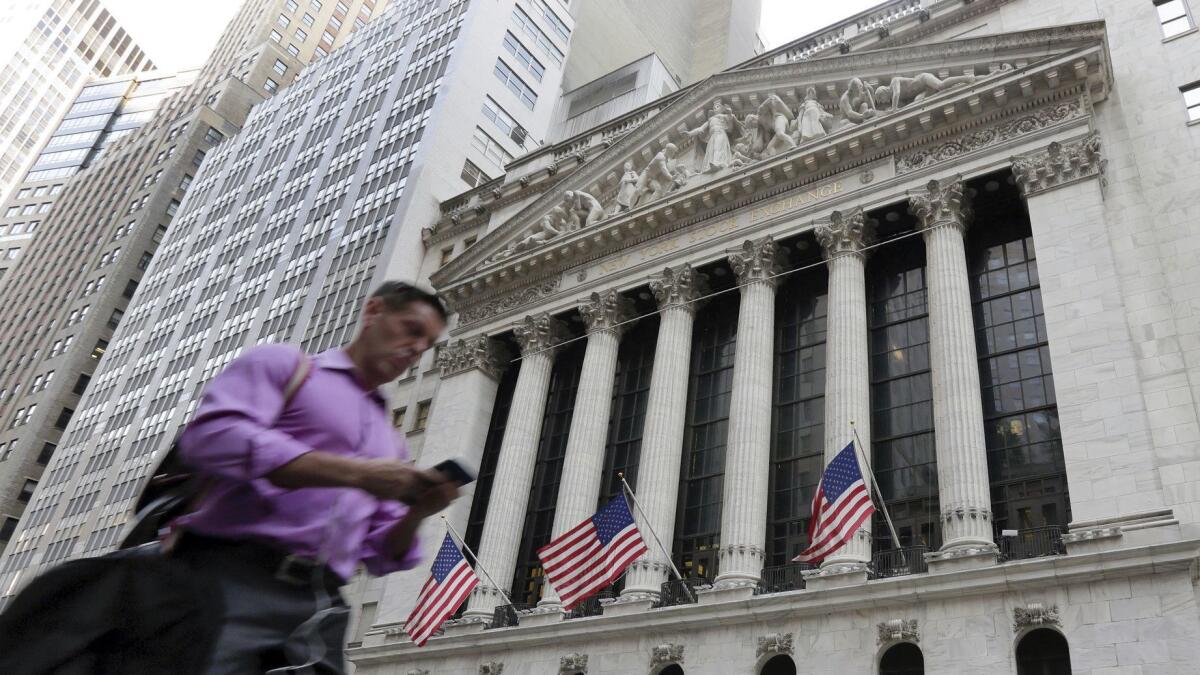Stocks hit new highs in a late burst of buying

- Share via
Wall Street capped a week of milestones by delivering a couple more Friday.
A late-afternoon burst of buying lifted the major U.S. stock indexes, which had spent much of the day in a sideways drift. The gains nudged the benchmark Standard & Poor’s 500 and Nasdaq composite indexes to new closing highs for the second time this week. Both indexes also set record highs Tuesday.
The S&P 500 rose 13.71 points, or 0.5%, to 2,939.88. The broad index is now up 17.3% this year. The Dow Jones industrial average rose 81.25 points, or 0.3%, to 26,543.33, but ended the week slightly lower. The Nasdaq composite recovered from an early slide, adding 27.72 points, or 0.3%, to 8,146.40. The Russell 2000 index of smaller company stocks climbed 16.20 points, or 1%, to 1,591.82.
The market’s latest milestones came as investors weighed a mixed bag of corporate earnings. Solid quarterly reports from Ford and Amazon helped lift the market. Weaker showings from Intel and Exxon Mobil cut into the Dow’s gains.
Smaller company stocks fared better than the rest of the market, a bullish sign indicating that investors were more willing to take on risk.
Although company earnings were mixed, investors drew encouragement from a government report estimating that the U.S. economy grew at a solid 3.2% annual rate in the first three months of the year — a much bigger increase than expected.
Bond prices rose. The yield on the 10-year Treasury fell to 2.50% from 2.53% late Thursday.
The S&P 500’s latest all-time high underscores the market’s blockbuster turnaround this year after nosediving at the end of 2018 amid fears of a recession, an escalating trade war between the U.S. and China, and concern that the Federal Reserve was moving too aggressively to raise interest rates.
In the months since, those concerns have eased or taken a back seat to more optimism among investors about the prospects for steady economic growth.
Perhaps most of all, traders have been encouraged by an increasingly hands-off Fed, which has signaled it may not raise interest rates in 2019 after seven increases the previous two years.
U.S. companies are about a third of the way through their latest round of quarterly reports. So far they’ve avoided analysts’ most dire predictions for a severe contraction.
Wall Street’s strong recovery this year has helped fuel a surge in corporate deals. So far this year, there have been $711 billion in mergers and acquisitions in the U.S., the fastest start to a year on record, according to Dealogic.
The market has also been rewarding some technology companies since their highly anticipated stock market debuts. All told, 34 IPOs have been completed this year, raising $9.5 billion, down from 55 that raised $18.5 billion in the same period last year, said Kathleen Smith, principal at Renaissance Capital, a provider of pre-IPO research and IPO exchange-traded funds.
On Friday, gains in financial, healthcare and other sectors offset losses in technology stocks. ExxonMobil slid 2.1% after the oil company’s first-quarter profit fell by half, missing forecasts because of higher spending on oil production and lower margins in its refinery business. Exxon was part of a broad slide in energy-sector stocks Friday.
Brent crude, the international standard, fell 3% to close at $72.15 per barrel.
Gold rose 0.7% to $1,288.80 an ounce, silver gained 0.8% to $15.01 an ounce and copper added 0.9% to $2.89 per pound.
The dollar slipped to 111.61 Japanese yen from 111.62 yen late Thursday. The euro strengthened to $1.1154 from $1.1128.
More to Read
Inside the business of entertainment
The Wide Shot brings you news, analysis and insights on everything from streaming wars to production — and what it all means for the future.
You may occasionally receive promotional content from the Los Angeles Times.










